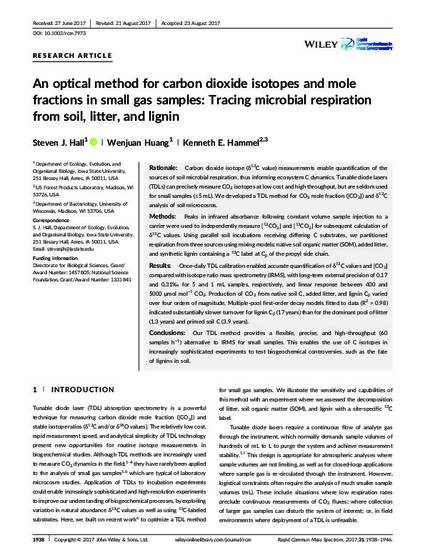
Rationale
Carbon dioxide isotope (δ13C value) measurements enable quantification of the sources of soil microbial respiration, thus informing ecosystem C dynamics. Tunable diode lasers (TDLs) can precisely measure CO2 isotopes at low cost and high throughput, but are seldom used for small samples (≤5 mL). We developed a TDL method for CO2 mole fraction ([CO2]) and δ13C analysis of soil microcosms. Methods
Peaks in infrared absorbance following constant volume sample injection to a carrier were used to independently measure [12CO2] and [13CO2] for subsequent calculation of δ13C values. Using parallel soil incubations receiving differing C substrates, we partitioned respiration from three sources using mixing models: native soil organic matter (SOM), added litter, and synthetic lignin containing a 13C label at Cβ of the propyl side chain. Results
Once-daily TDL calibration enabled accurate quantification of δ13C values and [CO2] compared with isotope ratio mass spectrometry (IRMS), with long-term external precision of 0.17 and 0.31‰ for 5 and 1 mL samples, respectively, and linear response between 400 and 5000 μmol mol−1CO2. Production of CO2 from native soil C, added litter, and lignin Cβ varied over four orders of magnitude. Multiple-pool first-order decay models fitted to data (R2 > 0.98) indicated substantially slower turnover for lignin Cβ (17 years) than for the dominant pool of litter (1.3 years) and primed soil C (3.9 years). Conclusions
Our TDL method provides a flexible, precise, and high-throughput (60 samples h−1) alternative to IRMS for small samples. This enables the use of C isotopes in increasingly sophisticated experiments to test biogeochemical controversies, such as the fate of lignins in soil.
Available at: http://works.bepress.com/steven_hall1/19/

This article is published as Hall, Steven J., Wenjuan Huang, and Kenneth E. Hammel. "An optical method for carbon dioxide isotopes and mole fractions in small gas samples: Tracing microbial respiration from soil, litter, and lignin." Rapid Communications in Mass Spectrometry 31, no. 22 (2017): 1938-1946. doi: 10.1002/rcm.7973.